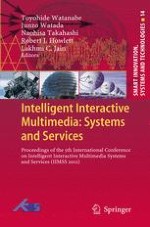2012 | Book
Intelligent Interactive Multimedia: Systems and Services
Proceedings of the 5th International Conference on Intelligent Interactive Multimedia Systems and Services (IIMSS 2012)
Editors: Toyohide Watanabe, Junzo Watada, Naohisa Takahashi, Robert J. Howlett, Lakhmi C. Jain
Publisher: Springer Berlin Heidelberg
Book Series : Smart Innovation, Systems and Technologies
